Art & Exhibitions
In an Old Venice Hospital, 10 Artists Explore the Hazy Space Between Cinema and Art
The exhibition, called “Nebula,” reflects the aims of the organization that put it together: Fondazione in Between Art Film.
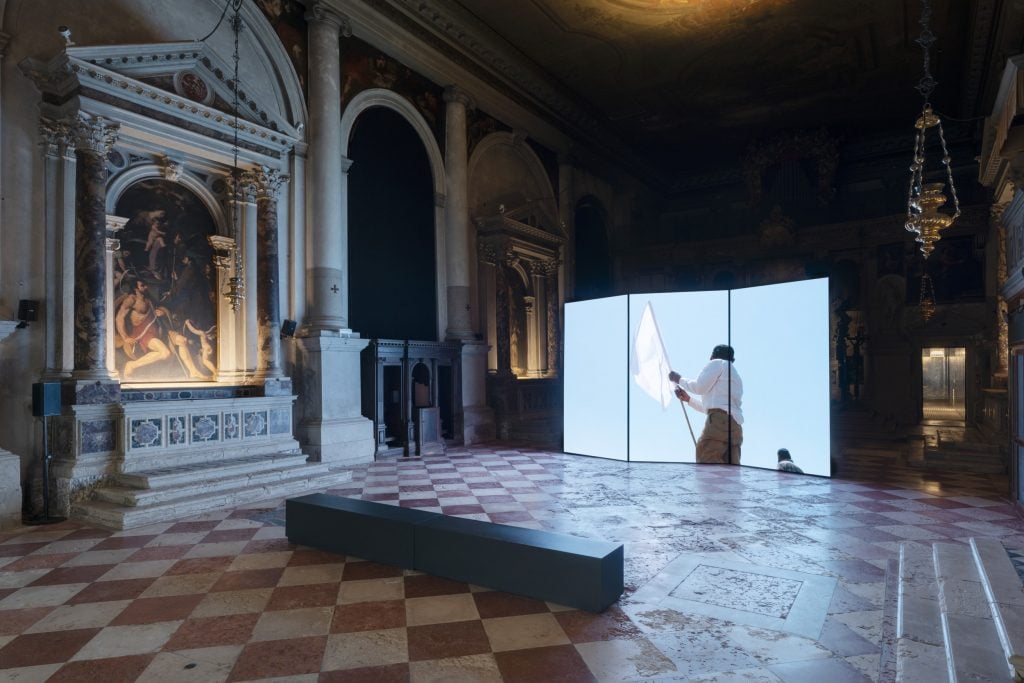
In Italy, where masterpieces of 14th, 15th, and 16th-century art are as common as corner stores, you become extra aware of the newness of film—and reminded that the medium came of age with, and was shaped by, all the formal obsessions of the 20th century. With its technological constraints, rectangular screens, and vacuum-packed viewing conditions, there is a rigidity to film that, even in galleries and museums, can be hard to shake.
Very little is rigid in “Nebula,” an exhibition of new site-specific video installations staged alongside the 2024 Venice Biennale. To some extent, that’s owed to the building it occupies: the Complesso dell’Ospedaletto, a 16th-century church and hospital shaped, inside and out, by both the ornate architectural age of its creation and the many patchwork updates required to maintain it since. But more than that, the show reflects the organization behind it: Fondazione in Between Art Film.
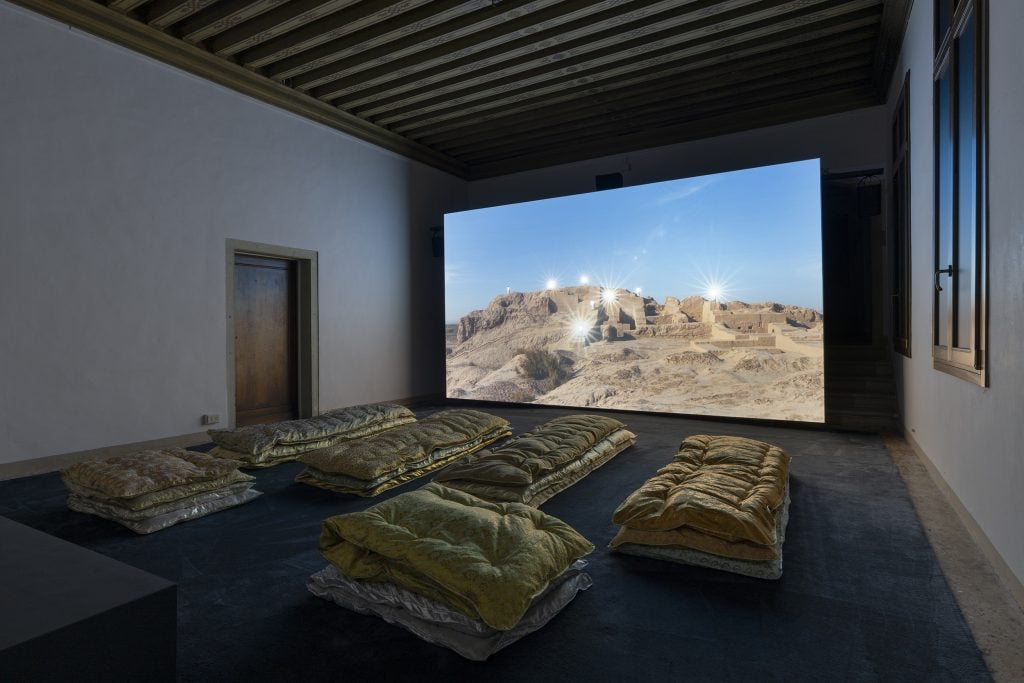
Saodat Ismailova, Melted into the Sun (2024) in “Nebula,” Fondazione In Between Art Film at Complesso dell’Ospedaletto, Venice, 2024. Courtesy of the artist, and Fondazione In Between Art Film. Photo: Lorenzo Palmieri.
Launched by Beatrice Bulgari in 2019, the nonprofit’s name tips us to its goals: this is an initiative dedicated to supporting works of time-based media that settle in the hazy mandorlas between overlapping mediums and genres. The foundation itself, which is technically based in Italy but operates itinerantly on a project-by-project basis, comfortably exists in such a space. “The term ‘In Between’ emerged from a question I had been grappling with: ‘Are we limited by the creative disciplines that have long existed, or can the convergence of artistic practices pave the way for new forms of expression?’” explained Bulgari, the foundation’s president.
Bulgari’s background is in cinema, where she worked for years as a costume designer, but it was an interaction with a cross-disciplinary documentary by the late, great Italian director Ermanno Olmi that inspired her interest in the muddy middle. The poetic film, Atto unico di Jannis Kounellis (2007), follows the eponymous artist as he installs a large, unwieldy sculpture made of metal, coal, stone, and animal products in Milan. “The film not only captured the process of creating the artwork but also Kounellis’s humor and spirit, along with the slow and often agonizing construction of the installation,” said Bulgari. “Olmi’s approach reflected his profound sensitivity and awareness of the fleeting nature of life, which was evident in his urgent need to communicate the details of the artwork.”
Organized by Alessandro Rabottini, the foundation’s artistic director, and Leonardo Bigazzi, its curator, “Nebula” is a quasi-sequel to “Penumbra,” a similarly-sized exhibition held at the same venue during the 2022 Venice Biennale. The curatorial conceit of the earlier show was based on the condition suggested by its title, a word that connotes both the gradated rim of a shadow and the dim light that comes when evening wanes into night.
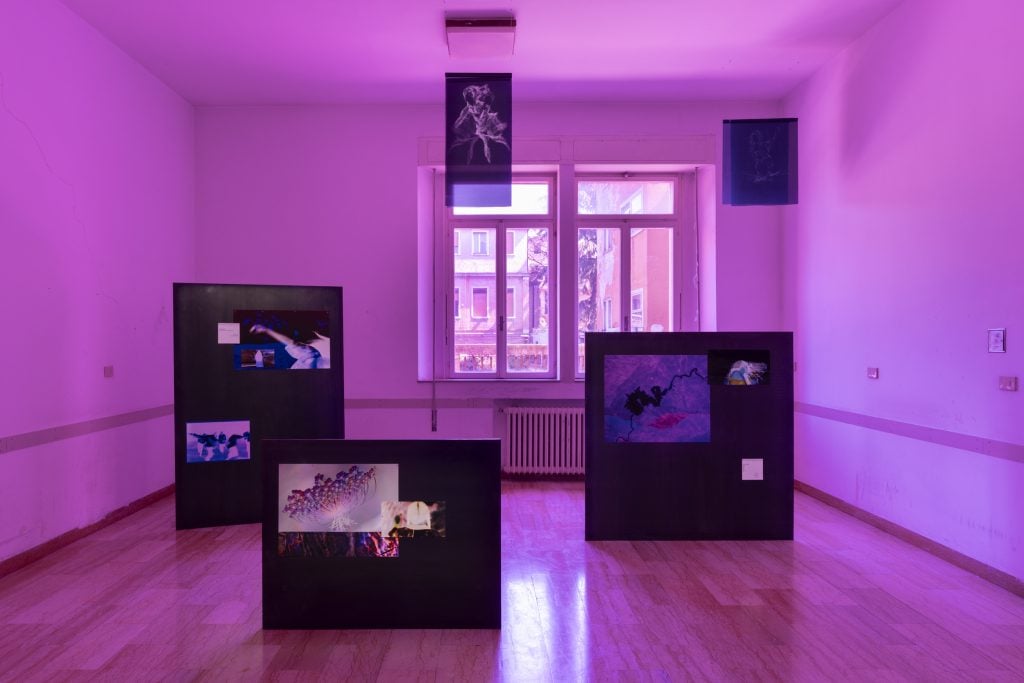
Basel Abbas and Ruanne Abou-Rahme, Until we became fire and fire us (2023–) in “Nebula,” Fondazione In Between Art Film at Complesso dell’Ospedaletto, Venice, 2024. Courtesy of the artists, and Fondazione In Between Art Film. Photo: Lorenzo Palmieri.
“Nebula” derives from the Latin word for mist, and with the 2024 exhibition Rabottini and Bigazzi sought to conjure a similar atmosphere. “We came up with this idea of fog, the moment when your capacity to see is blurred,” said Rabottini. “Fog is very pervasive. You can’t touch or locate it, but it conditions your movements. Your sense of distance is not fully functioning, and you don’t know what surrounds you. You feel a little lost.”
This is fertile territory for art, but the curators’ text for the show suggests the idea has broader implications for our time. “This exhibition deploys the image of fog as a metaphor for myriad different forms of disorientation, as a phenomenon that shifts from being atmospheric to become inner and collective—a mist that pervades not only the visual field but an entire epoch,” the passage, which appears in a booklet accompanying the show, reads. At the heart of this project, Rabottini and Bigazzi suggest, is a pair of paradoxical provocations: “Can a partial or obfuscated vision generate new meanings? Can uncertainty open up new spaces of mutual understanding?”
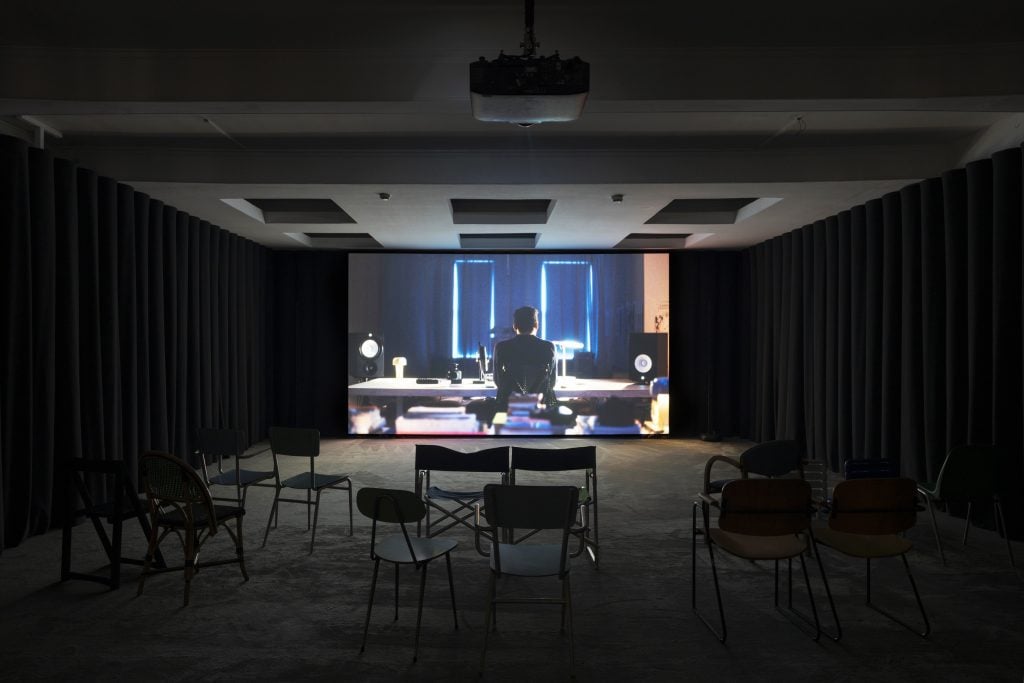
Christian Nyampeta, When Rain Clouds Gather (2024) in “Nebula,” Fondazione In Between Art Film at Complesso dell’Ospedaletto, Venice, 2024. Courtesy of the artist, and Fondazione In Between Art Film. Photo: Lorenzo Palmieri.
The show’s 10 artists go about tackling this prompt in manifold ways. Christian Nyampeta’s When Rain Clouds Gather (2024) follows a group of New York 30-somethings as they argue over art, activism, and the banal annoyances of daily life while the prospect of an invisible war looms. In Cinthia Marcelle and Tiago Mata Machado’s poetic reflection on displacement, Acumulacao Primitiva, a family sits amid what’s left of their destroyed home while a bulldozer pushes piles of dirt and a worker erects a white picket fence. It’s as if those responsible for razing the property are unaware that the inhabitants are still living there.
Other artists aren’t afraid to get a little meta. That’s the case for Basir Mahmood’s and his film Brown Bodies in an Open Landscape Are Often Migrating, the show’s first and richest work. Working from social media-sourced footage, the three-screen video ostensibly attempts to recreate the journey of a migrant, but what it focuses on is the film crew supporting the production. As they sweat and yell across a baron desert landscape, a different vision of the migrant experience emerges.
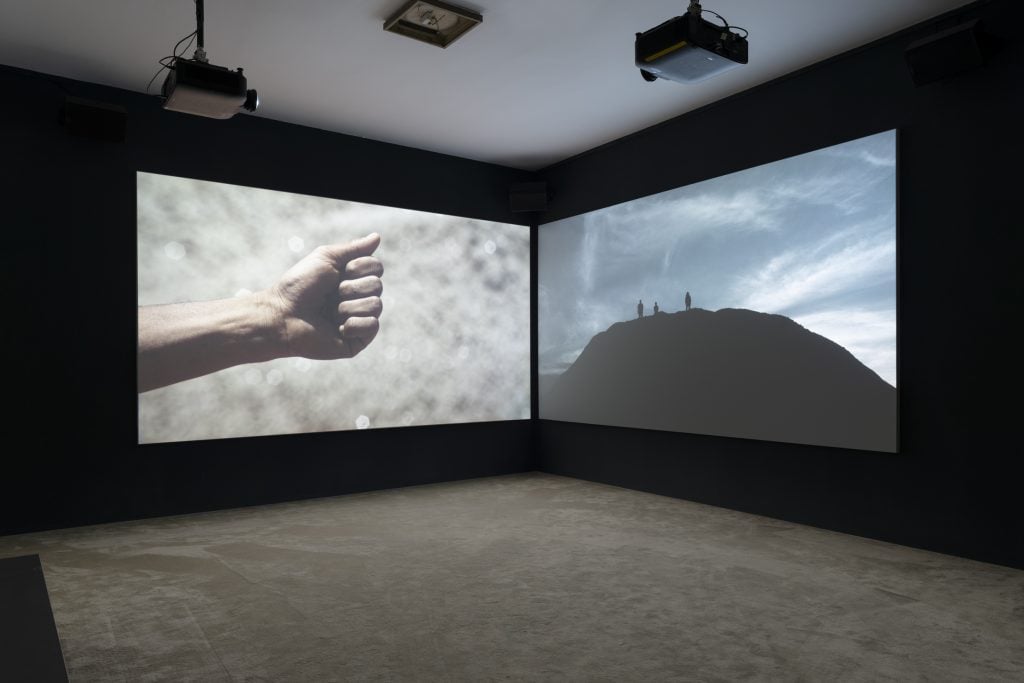
Cinthia Marcelle and Tiago Mata Machado, Acumulação Primitiva (2024) in “Nebula,” Fondazione In Between Art Film at Complesso dell’Ospedaletto, Venice, 2024. Courtesy of the artists, and Fondazione In Between Art Film. Photo: Lorenzo Palmieri.
There is, too, a meta-ness to Giorgio Andreotta Calo’s film Nebula (2024), which follows a sheep wandering the Complesso dell’Ospedaletto. In this case, though, the self-referentiality is pushed to surreal ends. Here, the sheep becomes the shepherd, we its flock. It leads through the halls of the abandoned building, slowly and aimlessly, stopping for the occasional nap. But the innocuousness of the ovine animal’s activity is undercut but an ominous droning soundtrack that suggests something sinister at play.
Diego Marcon’s Fritz (2024) also explores the dissonance between sound and image. The short, looping film shows an animated boy hanging from a noose while trying to yodel. Whereas Calo’s film skews Lynchian, Marcon’s recalls the violent, uncanny work of Jordan Wolfson.
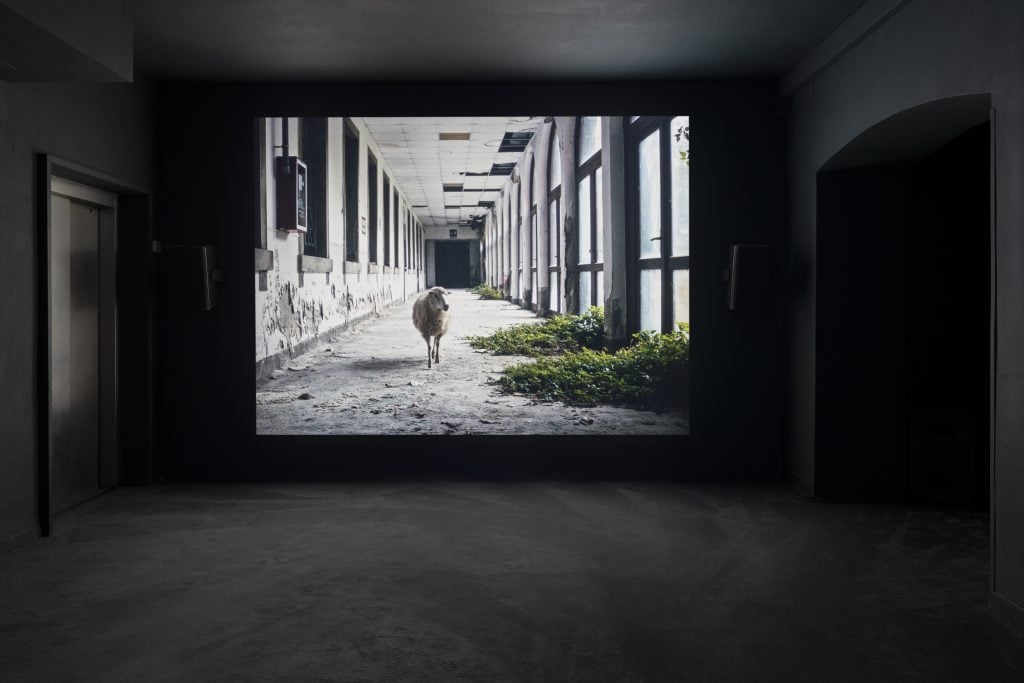
Giorgio Andreotta Calò, Nebula (2024) in “Nebula,” Fondazione In Between Art Film at Complesso dell’Ospedaletto, Venice, 2024. Courtesy of the artist, and Fondazione In Between Art Film. Photo: Lorenzo Palmieri.
At this moment, Rabottini summed up, “we’re surrounded by the idea of being loud with a very clear message. But this show is about how difficult it is to locate certain things and how one needs to constantly exercise critical thinking in their search.”
There’s an irony to the way the curator so precisely articulates the sensation of disorientation. For Fondazione in Between Art Film, a relatively new organization still introducing itself to the world, “Nebula” succeeds with a similar trick. In conception and execution, the show makes for a clear-eyed introduction to the foundation’s mission—and that mission is to remain in the fog.
“I am interested in breaking down categories within the artistic field to explore how dialogue between artistic mediums can inspire innovative forms of creative expression,” said Bulgari.





